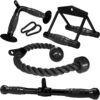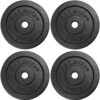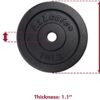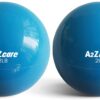The 5 Most Common Gym Injuries—and How to Prevent Them

Whatever your fitness goals, getting injured surely isn’t one of them. But according to a study from the University of Arkansas, there has been a 35 percent increase in gym injuries in recent years.
Personal trainer Justin Price, M.A., who owns The BioMechanics, a corrective exercise and functional fitness facility in San Diego, says there are two main reasons for workout-related injuries. The first is poor posture during the day, which eventually weakens your entire musculoskeletal structure. To combat this, make sure your computer screen is positioned in a way that you’re not straining or hunching to see it. The other mistake is trying to do too much too fast, in both reps and weight. “The problem that got you into the gym didn’t happen overnight, so you can’t undo it overnight,” says Price.
In other words, those 50 pounds can’t be erased in one mega-marathon treadmill session. And popping blood vessels by overweighting the bench press isn’t going to take you from Christian Bale in The Machinist to Christian Bale in Batman in one hard-core workout.
To get started, find a certified personal trainer (Price recommends one with the P.T.A. Global, N.S.C.A., or N.A.S.M. certifications) to make sure you’re using the right technique and try to think of yourself as your trainer by not making your goals too personal. “Think of working on your body as a third party. If you remove your ego from the situation you can be realistic about your goals,” says Price. You’ll be able to prevent injuries like the ones below, which Price says he sees most often.
1. Foot and ankle
Cause: When trying to explain foot and ankle injuries, Price starts at the top of the body. “People spend their days in front of their computer with rounded shoulders. When your shoulders are rounded and you stand up, your weight falls to the front of your foot,” says Price. Take that misplaced center of gravity and put it into running shoes, which naturally tip you forward with a heel higher than the toe, and your feet and ankles start to bear the brunt of any impact.
Prevention: “You should look for a running shoe that isn’t too high in the heel, or try a walking shoe, cross trainer, or tennis shoe,” suggests Price. By helping spread the impact to the whole foot, you’ll prevent problems like plantar fasciitis, Achilles tendonitis, anterior compartment syndrome (compression in the front of the ankle), lateral compression syndrome (compression at the side of the ankle), and bunions.
2. Knee
Cause: That damn desk job again, unfortunately. “We don’t use our hip muscles during the day. Then we decide to go kickbox or do Bootcamp,” says Price. The result is an injury to the . . . knee? “If our feet aren’t stable, due to improper footwear, and our hip muscles aren’t strong, the knee gets all the stress,” says Price, who says that leg extensions, curls, and presses don’t help resolve the problem because they don’t strengthen the muscles of the feet and hips.
Prevention: “A better exercise would be lunges. With a lunge your hip and ankle are bending together, stabilizing and strengthening the knee,” says Price. To get even more benefit, do lunges both forwards and backward, then side to side (also known as “step and squats”).
3. Lower back
Cause: Three strikes and your day job is officially in the dog house in terms of your physical health. “If someone is rounded throughout the day in their upper back, and then they go to the gym and do an overhead shoulder lift standing, their upper back cannot extend properly. They straighten and arch upward from their lower back, which has a nervous breakdown [anything from soreness to more permanent injury] because it’s getting all the stress,” says Price.
Prevention: Remember to stretch and strengthen your upper back to compensate for all that hunching you do at the office. Price suggests super-setting in straight-armed wall squats in with the rest of your lifting regimen. “Sit against a wall. Flatten your lower back into the wall, by tilting your pelvis under you. Straighten your arms in front of you, and try to raise arms to your ears, without letting a gap form behind your lower back,” says Price. And whenever you can, exercise standing up—really, you’ve sat enough at the office, right? “Standing helps you engage bigger muscles in your body,” says Price.
4. Shoulder
Cause: If you haven’t been convinced to hang up your mouse and pick up a hard hat, this just might do it. That carpal tunnel you’re complaining about 9-5 could contribute to a gym injury after-hours. “Your arms have to internally rotate when you type, which puts pressure on the shoulders,” says Price. “Then you go to the gym and do chest press, shoulder press, pushups, all also with your arms rotated in,” he notes. The outcome? Supraspinatus tendonitis, an overuse injury of the rotator cuff.
Prevention: You need to externally rotate your arms to balance your shoulders, and a great way to do that is by rowing with cables. “Grab the cables in front of you and pull the arms back, rotating your palms away from you and behind you,” says Price.
Whatever your fitness goals, getting injured surely isn’t one of them. But according to a study from the University of Arkansas, there has been a 35 percent increase in gym injuries in recent years.
Personal trainer Justin Price, M.A., who owns The BioMechanics, a corrective exercise and functional fitness facility in San Diego, says there are two main reasons for workout-related injuries. The first is poor posture during the day, which eventually weakens your entire musculoskeletal structure. To combat this, make sure your computer screen is positioned in a way that you’re not straining or hunching to see it. The other mistake is trying to do too much too fast, in both reps and weight. “The problem that got you into the gym didn’t happen overnight, so you can’t undo it overnight,” says Price.
In other words, those 50 pounds can’t be erased in one mega-marathon treadmill session. And popping blood vessels by overweighting the bench press isn’t going to take you from Christian Bale in The Machinist to Christian Bale in Batman in one hard-core workout.
To get started, find a certified personal trainer (Price recommends one with the P.T.A. Global, N.S.C.A., or N.A.S.M. certifications) to make sure you’re using the right technique and try to think of yourself as your trainer by not making your goals too personal. “Think of working on your body as a third party. If you remove your ego from the situation you can be realistic about your goals,” says Price. You’ll be able to prevent injuries like the ones below, which Price says he sees most often.
Source: mensjournal











